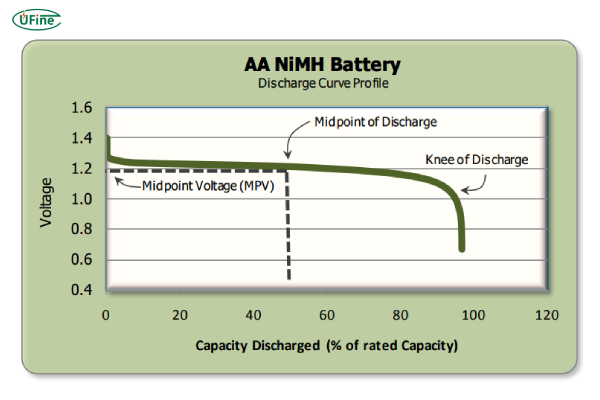Alkaline batteries power many of our everyday devices, from flashlights to remotes and toys. But how much voltage do these batteries really provide? Whether you’re curious about the types of alkaline batteries, the voltage curve, or how to check battery voltage, understanding alkaline battery voltage is important for both efficient use and replacement. In this guide, we will explore the maximum and minimum voltages of different alkaline batteries, the voltage curve characteristics, and how to check the voltage to ensure you’re getting the most out of your battery.
Part 1. Alkaline battery types
Alkaline batteries come in a variety of sizes and forms, but they are all designed to provide a specific voltage for various devices. Understanding these types can help you choose the right battery for your needs.
Alkaline batteries are classified into different types primarily based on their size and voltage. The most common types include:
- AA Alkaline Battery: This is the most commonly used size in household devices. The nominal voltage is 1.5V.
- AAA Alkaline Battery: A smaller version of the AA, often used in smaller devices like remotes or flashlights. Its nominal voltage is also 1.5V.
- 9V Alkaline Battery: Often used in smoke detectors and other specialized applications. Its nominal voltage is 9V.
- C and D Alkaline Batteries: These larger batteries are used in more power-hungry devices like toys and flashlights. They also provide 1.5V.
AA vs C vs D battery: A Comprehensive Comparison
While these alkaline batteries all provide 1.5V nominal voltage, the exact voltage can vary depending on the battery’s size and charge state.
Part 2. Alkaline battery maximum voltage
The maximum voltage of an alkaline battery refers to the peak voltage the battery can deliver when fully charged.
- AA and AAA Alkaline Batteries: When fully charged, these batteries typically provide a 1.6V peak voltage. This is the highest voltage you’ll see when the battery is fresh out of the pack.
- 9V Alkaline Battery: A fully charged 9V battery can provide up to 9.6V, which is the maximum voltage it can deliver before the voltage starts to drop.
- C and D Alkaline Batteries: These larger batteries also provide a peak voltage of 1.6V when fully charged, just like AA and AAA.
It’s important to note that the maximum voltage only occurs when the battery is new or just fully charged. Over time, as the battery discharges, the voltage will gradually decrease.
Part 3. Alkaline battery minimum voltage
The minimum voltage refers to the point at which the battery’s voltage is too low to effectively power a device. At this stage, the battery is usually considered “dead,” although it might still hold a small charge.
- AA and AAA Alkaline Batteries: The minimum voltage for these batteries is typically around 0.9V. Below this point, they are generally no longer able to effectively power most devices.
- 9V Alkaline Battery: For a 9V battery, the minimum voltage is usually around 6V. Once it falls below this threshold, the battery won’t be able to power devices like smoke detectors.
- C and D Alkaline Batteries: Like AA and AAA, these larger batteries also have a minimum voltage around 0.9V. When the voltage drops below this level, they can no longer power high-drain devices effectively.
Remember that while a battery can still hold some voltage below the minimum, it’s no longer useful for most tasks.
Part 4. Alkaline battery voltage curve
The voltage curve of an alkaline battery shows how its voltage changes over time as it discharges. This curve is important to understand because it affects how long the battery can power your device.
Characteristics of the Alkaline Battery Voltage Curve:
- Initial Drop: When first used, the voltage of an alkaline battery tends to drop slightly from its peak (around 1.6V) within the first few hours of use.
- Gradual Decline: After the initial drop, the voltage remains fairly stable for a large portion of the battery’s life. During this phase, the battery can still power most devices effectively.
- Rapid Decline: As the battery nears depletion, the voltage drops more sharply. This is when you’ll notice devices starting to lose power or fail to turn on.
- End-of-Life: Once the battery voltage falls below its minimum voltage (0.9V to 1V for AA/AAA, 6V for 9V), it can no longer provide reliable power.
Understanding this curve is key to managing battery life and knowing when to replace your alkaline battery before it completely drains.
Part 5. How to check the voltage of alkaline batteries?
Knowing how to check the voltage of an alkaline battery can help you avoid using batteries that are too low to be effective.
Using a Multimeter:
- Set the multimeter to DC voltage mode.
- Place the red probe on the positive terminal of the battery and the black probe on the negative terminal.
- The multimeter will display the voltage. If it shows 1.5V (or higher), the battery is good. If it shows below 1.0V for AA/AAA, or below 6V for a 9V battery, it’s time to replace it.
Using a Battery Tester:
Battery testers are inexpensive devices designed specifically to measure the voltage of batteries. Simply insert the alkaline battery into the tester, and it will show you the voltage on a scale, often with a color-coded indicator.
Checking the voltage regularly can help you determine whether it’s time to replace the battery before your device starts losing power.
Part 6. How low can alkaline battery voltage be useful?
So, how low can an alkaline battery voltage go before it’s no longer useful? The general rule is:
- AA and AAA Batteries: Once the voltage drops below 1.0V, you’ll likely notice a drop in performance, and the battery is no longer efficient. At 0.9V or lower, it’s usually time to replace the battery.
- 9V Batteries: When the voltage drops below 6V, a 9V alkaline battery is generally not useful for most devices. It’s time to replace it.
- C and D Batteries: These larger batteries follow a similar pattern to AA and AAA. Below 1.0V, they won’t be useful for most tasks.
Part 7. FAQs
-
How do I know when my alkaline battery is dead?
When the voltage drops below the minimum voltage (around 0.9V for AA/AAA, 6V for 9V), the battery can no longer power your device effectively, signaling it’s time to replace it. -
Can an alkaline battery still work if the voltage is low?
It can still work for low-power devices, but performance will be unreliable, and it’s likely to fail soon. If you notice devices not functioning properly, replace the battery. -
How can I prolong the life of my alkaline battery?
To get the most out of your alkaline battery, avoid draining it completely, store it in a cool, dry place, and remove it from devices that aren’t in use for extended periods. -
Are 9V alkaline batteries more powerful than AA batteries?
Yes, a 9V battery delivers 9 volts of power compared to the 1.5V of an AA battery. However, AA batteries are more common for household devices, while 9V batteries are used in specialized devices like smoke detectors. -
Can I use a multimeter to measure the voltage of a 9V battery?
Yes! A multimeter can easily measure the voltage of a 9V battery. Just set the multimeter to DC voltage and check the reading. If it’s below 6V, the battery is no longer useful.
Related Tags:
More Articles

How to Choose the Best Floor Scrubber Battery for Commercial Cleaning?
Selecting the ideal floor scrubber battery ensures a long runtime, rapid charging, and minimal maintenance for efficient commercial cleaning operations.
Battery for Blower vs Battery for Leaf Vacuum: Which One Should You Choose?
Battery for blower vs leaf vacuum—learn the key differences in power, fit, and runtime to choose the right battery for your outdoor tool needs.
How to Choose the Right Battery for Blower?
Choosing the right blower battery? Consider voltage, capacity, chemistry & usage. This guide helps match the best battery for peak performance.
How to Choose the Best Insulated Battery Box for Lithium Batteries?
Choosing the Best Insulated Battery Box for Lithium Batteries? Discover key factors such as size, material, and safety for optimal protection and performance.
7 Critical Elements on a Lithium Battery Shipping Label
What must be on a lithium battery shipping label? Learn 7 key elements to ensure safety, legal compliance, and correct handling across all transport modes.





